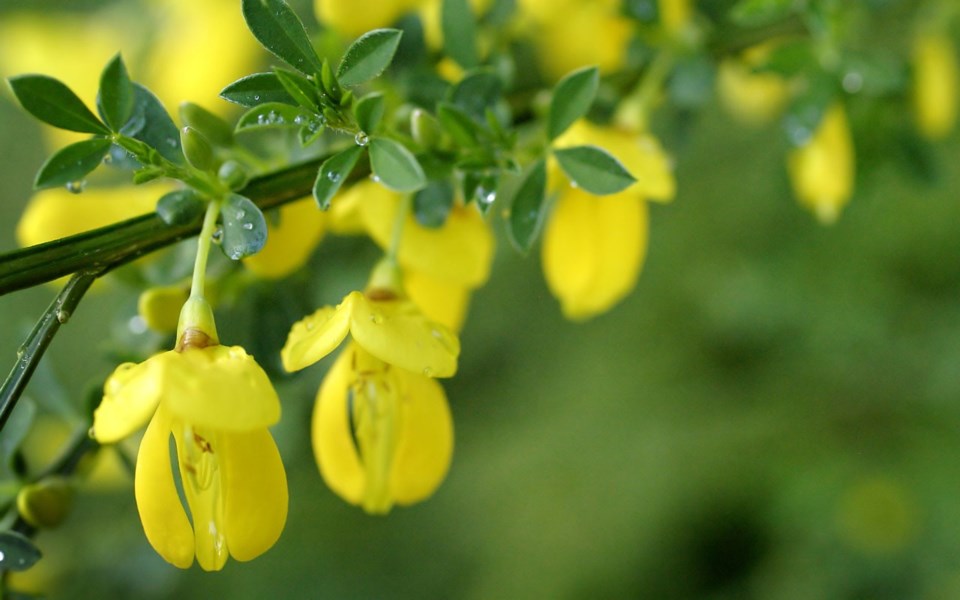If the outside temperature as I write this means anything, it's definitely spring—that time of year when our human fancy turns to love, mountain biking, hockey playoffs and gardening.
Nature is also waking up and looking to do what she always does: rejuvenate. So I wasn't too surprised on a trip to Vancouver Island last weekend to see one of the first harbingers of spring waving to me near the Horseshoe Bay ferry dock—the bright yellow flowers of a Scotch broom. Too bad this particular harbinger is a dangerous and unwelcome one.
As its name implies, Scotch broom (Cytisus scoparius) is not native, and has, in fact, proven one of the worst plant invaders in the Pacific Northwest, sitting at No.4 on the Sea to Sky Invasive Species Council's (SSISC) list of Whistler's five worst weeds. Other than the springtime explosion of pleasing florescence that everyone seems to like (one of the reasons it manages to insinuate itself in an area before someone realizes it's a problem), the tough, woody shrub creates a host of problems where it takes root.
To start, this sun-lover out-competes many native flora, especially in the endangered Garry Oak ecosystems of northwest Washington state and southwestern British Columbia where it grows in dense stands in fields, meadows, pastures, hillsides and edge habitats. It does this through a range of means that include fixing nitrogen that favours other non-native plants, and being allelopathic—meaning it releases chemicals that inhibit the growth of competing native plants.
It's also a significant fire hazard—its love of hillsides and forest edges added to the region's pervasively changing climate making it more so. A single large shrub might produce 18,000 to 20,000 seeds each year that can then be distributed passively by gravity, vehicles (via tires), people (clothing and footwear), all kinds of animals (fur and feathers), or the movement of contaminated soil, as well as actively via the plant's own exploding-pod broadcast mechanism that can literally shoot seeds up to five metres distance. Those seeds can remain viable in the soil for up to 80 years (but more typically 20 to 40), and are generally induced to germinate by disturbance—like earthmoving or fire.
The shrub can also re-grow vegetatively from cut stems. As such, it's more or less a perfect invader that can multiply rapidly to produce dense monocultures that are both unsightly and can change entire ecosystems.
How big of a problem is it in B.C.? Just ask people on the Gulf Islands and southern Vancouver Island, where roadsides are lousy with Scotch broom, some of it three metres tall (for a real eye-opener check out the BC Hydro corridor through Squamish). One particularly troublesome trait in a place like B.C. with such an active forestry industry is that Scotch broom inhibits reforestation by outcompeting conifer seedlings and increasing wildfire fuel loads, with phenols and oils in the plant escalating fire intensity. On our drive across the island last week from Nanaimo to Port Renfrew it was everywhere along roadsides—even logging roads where it had penetrated far into replanted cutblocks.
We've had a few broom take hold in Whistler over the years, but nothing like our more southerly neighbours, and Early Detection Rapid Response (EDRR) diligence by Bob Brett of the Whistler Naturalists, and the SSISC has kept it at bay. Like many other plant interlopers, it appears to have arrived in landfill used to shore up embankments for a newly widened highway; Brett recalls first pulling broom here around 1997, but because he clocks each site at least once a year while the plants are flowering, he's confident no broom has set seed in Whistler for at least 15 years. The SSISC also currently maintains a zero-tolerance control line for broom north of Squamish.
What this all means is that we're lucky in Whistler—so far—and that EDRR of a new introduction that might help prevent further spread will be taken up by the SSISC (you can report any broom sighting directly to the SSISC through its website or an Invasive Species Council of BC app.) Once broom establishes somewhere, it's there for good. Which explains why there are grassroots containment organizations like BroomBusters (broombusters.org) on the island, in which a shared sense of purpose breeds camaraderie that leads to annual AGMs, potluck dinners, and endless work details that turn on the seed-stopping motto "Cut Broom in Bloom"—the newest fancy we turn to in spring.
Leslie Anthony is a biologist, writer and author of several popular books on environmental science.




